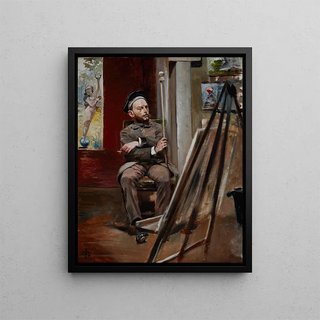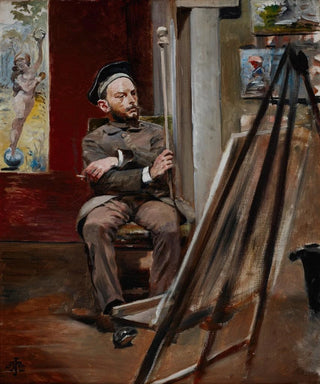Art print | Portrait of Stanisław Tondos - Jacek Malczewski


View from behind

Frame (optional)
Portrait of Stanisław Tondos Art print by Jacek Malczewski – Captivating introduction
The "Portrait of Stanisław Tondos" by Jacek Malczewski is a work that transcends the simple frame of painting to become part of the vibrant history of Polish art. Created at the end of the 19th century, this portrait depicts a man with penetrating eyes, whose expression seems to tell stories of life, passion, and struggle. The finesse of the details and the richness of the colors transport the viewer into a universe where every brushstroke is loaded with meaning. Through this work, Malczewski does not merely depict an individual; he evokes a time, a culture, and an artistic sensibility that still resonate today.
Style and uniqueness of the work
Jacek Malczewski's style is characterized by a unique blend of realism and symbolism, which is vividly expressed in the "Portrait of Stanisław Tondos." The composition is carefully crafted, with each element having its place and importance. The colors, both vivid and nuanced, create an almost mystical atmosphere, while the interplay of shadow and light reveals the psychological depth of the subject. Tondos's face is both familiar and enigmatic, a duality that invites contemplation. This work is not limited to a simple representation; it is an exploration of human emotions, the human condition, and the quest for identity—themes dear to Malczewski.
The artist and his influence
Jacek Malczewski, an emblematic figure of Polish art, knew how to mark his era with his innovative vision and his ability to fuse artistic influences of his time. Raised in a rich artistic context, he was nourished by symbolist and impressionist currents but developed a style that is uniquely his own. His work is often imbued with mythological and historical references, reflecting a deep reflection on Polish culture and national identity. Malczewski was also a pioneer in integrating psychology into his portraits, an approach that paved the way for many artists who followed him. His impact on Polish art

Matte finish

View from behind

Frame (optional)
Portrait of Stanisław Tondos Art print by Jacek Malczewski – Captivating introduction
The "Portrait of Stanisław Tondos" by Jacek Malczewski is a work that transcends the simple frame of painting to become part of the vibrant history of Polish art. Created at the end of the 19th century, this portrait depicts a man with penetrating eyes, whose expression seems to tell stories of life, passion, and struggle. The finesse of the details and the richness of the colors transport the viewer into a universe where every brushstroke is loaded with meaning. Through this work, Malczewski does not merely depict an individual; he evokes a time, a culture, and an artistic sensibility that still resonate today.
Style and uniqueness of the work
Jacek Malczewski's style is characterized by a unique blend of realism and symbolism, which is vividly expressed in the "Portrait of Stanisław Tondos." The composition is carefully crafted, with each element having its place and importance. The colors, both vivid and nuanced, create an almost mystical atmosphere, while the interplay of shadow and light reveals the psychological depth of the subject. Tondos's face is both familiar and enigmatic, a duality that invites contemplation. This work is not limited to a simple representation; it is an exploration of human emotions, the human condition, and the quest for identity—themes dear to Malczewski.
The artist and his influence
Jacek Malczewski, an emblematic figure of Polish art, knew how to mark his era with his innovative vision and his ability to fuse artistic influences of his time. Raised in a rich artistic context, he was nourished by symbolist and impressionist currents but developed a style that is uniquely his own. His work is often imbued with mythological and historical references, reflecting a deep reflection on Polish culture and national identity. Malczewski was also a pioneer in integrating psychology into his portraits, an approach that paved the way for many artists who followed him. His impact on Polish art






